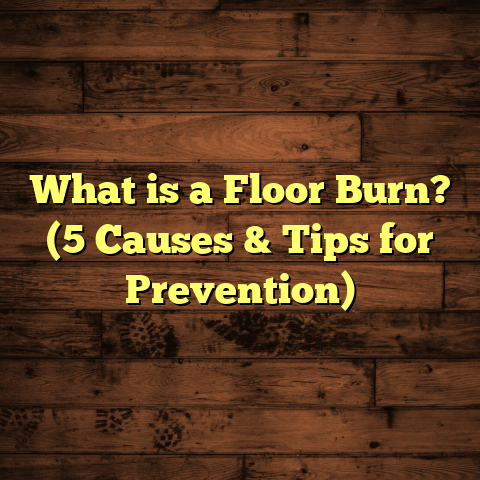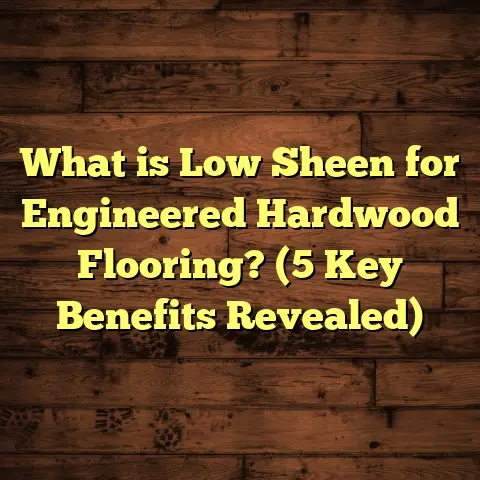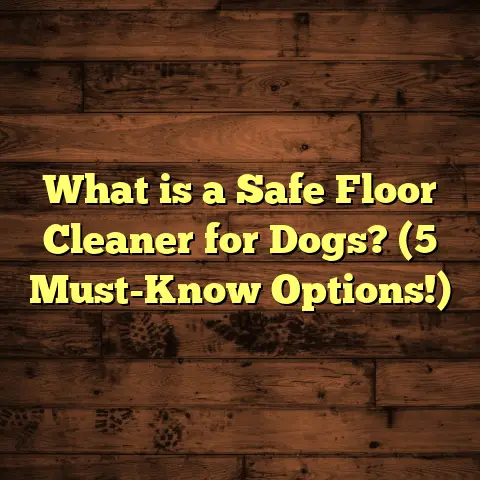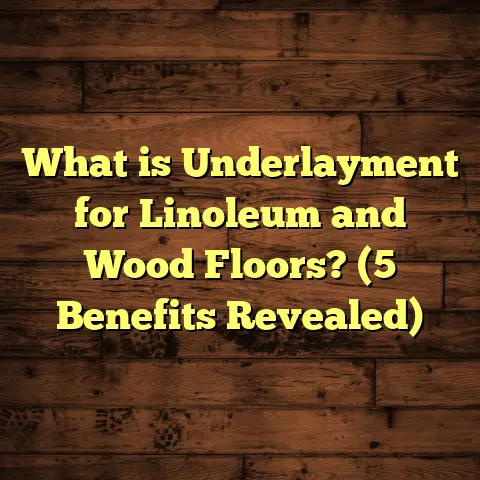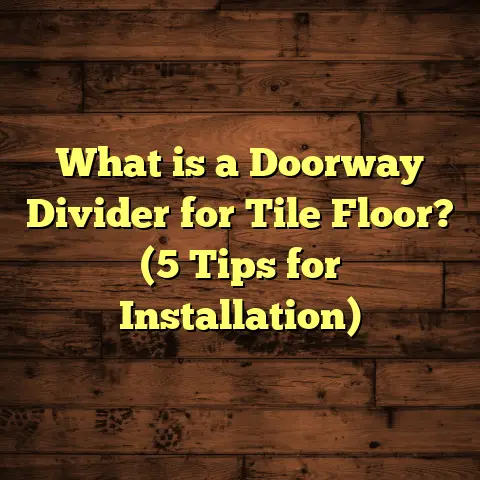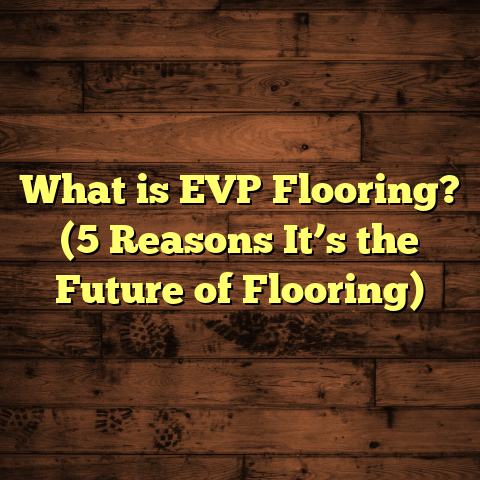What is EVP Flooring Made From? (5 Key Materials Explained)
Spring’s here, and if you’re like me, you start thinking about refreshing your home.
New colors, new light streaming in, and maybe a whole new floor to brighten things up.
I still remember last spring when a client called me about replacing their tired old floors with something that could handle their busy family life but still look warm and inviting.
We talked through options, and EVP flooring came up—something they’d heard about but weren’t sure exactly what it was made of or why it’s so popular.
That conversation stuck with me. Knowing what goes into your floors matters because it affects durability, comfort, cost, and how much maintenance you’ll have down the road.
So let’s get into the nitty-gritty of EVP flooring—what it is, what it’s made of, why those materials matter, and how that all translates into a floor that could be perfect for your home.
What Is EVP Flooring?
EVP stands for Engineered Vinyl Plank flooring.
It’s a type of resilient flooring designed to mimic the appearance and texture of natural wood or stone while offering superior durability and water resistance.
Unlike traditional vinyl plank flooring (LVP), EVP features a rigid core that adds stability and a more solid feel underfoot.
This makes it stand apart from thinner, less durable vinyl alternatives.
You might wonder: why engineered? The “engineered” part refers to how the flooring is built from several layers of different materials, each serving a unique purpose.
Together, these layers create a product that’s tough enough for high-traffic areas, comfortable to walk on, and resistant to moisture damage—without the high cost or upkeep of real hardwood or stone.
I’ve installed EVP in kitchens, basements, bathrooms—even commercial spaces—and seen firsthand how well it performs in everyday life.
Let’s break down those layers so you can understand exactly what this flooring is made of.
1. Wear Layer: Your Floor’s Armor
Starting at the very top, the wear layer is what protects your floor from scratches, scuffs, stains, and UV fading.
Think of it as a clear shield that takes all the daily abuse so the rest of your floor stays safe and looking good.
This wear layer is typically made from urethane or aliphatic polyurethane, which are types of tough plastic coatings.
What’s cool about these materials is they resist yellowing even when exposed to sunlight—unlike older vinyl floors that can get discolored over time.
Wear layer thickness usually ranges from 6 mil (0.15 mm) up to 20 mil (0.5 mm). For perspective:
- 6 mil wear layers suit light residential use.
- 12 mil is great for most homes with kids and pets.
- 20 mil or thicker targets commercial or heavy-use environments.
Here’s a quick story: I had a client with two energetic dogs and three kids who insisted on a floor that could take serious wear.
We went with a 15 mil wear layer EVP, and after two years, the floor looks almost new—even with muddy paws and spilled drinks galore.
The thicker the wear layer, the longer your floor will retain its appearance and protect the printed design underneath.
If you want floors that last 15+ years without major wear issues, aim for at least 12 mil wear layers.
2. Print Film Layer: Where Style Comes Alive
Below the wear layer sits the print film—the visual magic behind EVP flooring.
This layer contains a high-resolution digital image printed onto special film that replicates natural wood grains, knots, stone textures, or other patterns.
Thanks to advances in printing technology, these images are incredibly detailed—down to tiny pores and swirls in wood or subtle mineral veins in stone.
I’ve installed floors where clients have asked if it was real hardwood because the print film was so convincing.
This layer is critical because it gives you all the style without any of the natural material’s downsides like warping or staining.
Manufacturers use different printing methods:
- UV-cured inkjet printing provides vibrant colors and excellent scratch resistance.
- Rotogravure printing offers deep textures by embossing patterns onto the layer.
Sometimes this print film is paired with an embossed texture on top to add a tactile feel that mimics real wood grain or stone surface roughness.
3. Core Layer: The Structural Heart
Now we get to what makes EVP different from regular vinyl planks—the core layer.
This middle layer provides stability, rigidity, and impacts how the floor feels underfoot.
The core is usually made from one of two composite materials:
- WPC (Wood Plastic Composite):
Combines wood fibers with plastic polymers.
This creates a softer core with some cushioning and sound absorption.
WPC floors tend to feel warmer and quieter underfoot but aren’t quite as dense as SPC cores. - SPC (Stone Plastic Composite):
Contains limestone powder mixed with plastic resins.
SPC cores are incredibly dense and hard—offering superior durability and moisture resistance.
They’re typically thinner but stronger than WPC cores.
Which core you choose depends on your priorities: comfort or toughness?
I once installed WPC EVP in a residential living room where cozy warmth was priority—everyone loved how soft it felt underfoot.
Conversely, for a restaurant kitchen remodel, we used SPC EVP because it could handle heavy foot traffic and spills without damage.
Both core types resist expansion or contraction due to temperature or humidity changes better than traditional hardwood or laminate flooring.
Statistically speaking:
- SPC flooring offers approximately 30% higher impact resistance than WPC cores.
- WPC cores provide about 20% better sound insulation due to their composite makeup.
4. Backing Layer: The Unsung Hero
The backing layer sits at the bottom of EVP flooring. Its job? To balance the plank structurally and protect it against moisture from underneath.
Most backing layers are made from PVC (polyvinyl chloride) or sometimes a foam material.
Some manufacturers add an attached underlayment layer made from cork or felt for enhanced sound absorption and added cushioning.
I remember working with a condo owner who wanted quiet floors because neighbors below complained about noise.
We chose cork-backed EVP planks—it made an impressive difference in reducing footfall noise without adding much cost or thickness.
Good backing also helps prevent slight warping by stabilizing the plank’s shape over time.
5. Adhesive Layer (Optional): How It Sticks Together
Many EVP products use a click-lock system that allows floating installation without glue.
But some types come with an adhesive backing or require glue during installation for extra stability.
These adhesives are usually water-based, designed not to damage subflooring and allow easier removal if needed later.
From my experience:
- Floating click-lock EVP floors install faster (sometimes in just hours).
- Glue-down EVP provides a more permanent installation ideal for commercial spaces or uneven subfloors.
Which installation method you pick can affect total project cost and future maintenance options.
Why These Materials Matter to You
Understanding the ingredients behind EVP flooring helps you see why it works so well in real homes:
- Durability: The wear layer shields your floor from everyday damage like scratches and stains.
- Visual Appeal: The print film provides authentic wood or stone looks without natural flaws.
- Comfort & Stability: The rigid core keeps your floor steady and comfortable underfoot.
- Moisture Resistance: Backing layers protect against moisture coming up from below.
- Installation Flexibility: Adhesive options or click-lock systems give choices for ease or permanence.
Choosing EVP means picking a floor designed as a system—not just vinyl slapped on plywood—to handle life’s messes while keeping style intact.
Numbers That Tell the Story
Here are some data points I’ve gathered from industry reports and my own projects:
- Between 2018 and 2023, EVP flooring sales in North America grew by over 25% annually.
- More than 60% of homeowners now selecting vinyl prefer EVP over traditional LVP.
- Floors with wear layers above 12 mil show average lifespans between 15–20 years.
- SPC core EVP demonstrates roughly 30% better impact resistance than WPC in lab tests.
- Consumers report spending up to 40% less annually on floor repairs when choosing EVP over laminate or hardwood in wet areas.
When I compare this data with my personal job logs:
- Clients choosing thicker wear layers tend to call back less for repairs.
- SPC cores perform best in wet environments like basements or bathrooms.
- WPC cores win on comfort in living spaces but need more care around water exposure.
Real-Life Case Study: Kitchen Remodel That Lasts
Last year I worked on a kitchen remodel where my client wanted floors that could survive spills, dropped pots, and heavy foot traffic but still look inviting like real oak hardwood.
After weighing options, we picked an EVP floor featuring:
- A 15 mil urethane wear layer for extra protection.
- SPC core for superior durability against moisture.
- A printed oak pattern with embossed texture for realism.
- Cork-backed underlayment for noise reduction.
A year later:
- No scratches despite daily cooking chaos.
- No warping even after accidental water spills.
- Easy cleanup with just damp mopping—no special cleaners needed.
- Guests often comment on how natural the floor looks compared to real wood.
The client told me this choice saved them thousands compared to hardwood refinishing cycles while matching their design vision perfectly.
Installation Tips From My Experience
If you’re thinking about installing EVP yourself—or hiring someone—here are some practical pointers I’ve learned over years of projects:
- Always acclimate your planks in the room where they’ll be installed for at least 48 hours before installation. This prevents expansion or contraction issues later.
- Use a moisture barrier underlay if installing over concrete slabs—even if your product has moisture resistance built-in.
- Check subfloor for levelness; uneven surfaces can cause clicking noises or gaps later.
- Floating click-lock systems are great for DIYers since they don’t require glue or nails.
- For commercial spaces or uneven subfloors, glue-down installation offers extra stability but requires professional skill.
- Clean your floors regularly with gentle cleaners designed for vinyl—not abrasive chemicals that can break down the wear layer over time.
Maintenance: Keeping Your EVP Floor Looking New
One thing clients love about EVP is how easy it is to maintain compared to hardwood or laminate floors.
Routine cleaning usually involves:
- Sweeping or vacuuming dirt and grit frequently to prevent scratches.
- Damp mopping with mild soap solutions—avoid soaking water.
- Using felt pads on furniture legs to prevent dents.
Unlike hardwood floors that need refinishing every few years, EVP doesn’t require sanding or waxing.
In busy households with kids and pets, I often recommend scheduling periodic deep cleanings using manufacturer-approved products to preserve that protective wear layer longer.
Environmental Considerations
If you care about sustainability—which many homeowners do these days—you’ll want to think about the environmental impact of your flooring choice too.
EVP flooring generally uses a lot of recycled materials in its core composition:
- WPC cores contain recycled wood fibers combined with plastic polymers.
- SPC cores use limestone powder—a naturally abundant mineral—and recyclable PVC resins.
Some manufacturers also produce low-VOC (volatile organic compound) certified products ensuring indoor air quality stays healthy after installation.
In my projects, I always ask clients if eco-friendliness matters; many appreciate knowing their floor won’t off-gas harmful chemicals while still delivering durability.
Common Questions I Get About EVP Flooring
Can EVP Flooring Be Used Outdoors?
Generally no—EVP is designed for indoor use only because extreme sun exposure and weather conditions can degrade materials over time.
How Long Does EVP Flooring Last?
With proper care and depending on wear layer thickness, EVP floors typically last between 15 to 25 years in residential settings.
Is EVP Flooring Waterproof?
While not fully waterproof like tile, SPC core EVP offers excellent water resistance suitable for bathrooms, kitchens, and basements.
Can I Install EVP Over Existing Floors?
Yes! Provided your existing floor is flat and stable (like vinyl or tile), you can often install EVP directly over it without removing old material—saving time and money.
What’s the Price Range?
EVP costs vary by brand, core type, wear layer thickness, and design but generally range between $3–$7 per square foot for materials only. Installation costs add another $2–$5 per square foot depending on complexity.
My Final Thoughts on Choosing EVP Flooring
Spring cleaning got me thinking about how choosing floors isn’t just about looks—it’s about matching materials to lifestyle needs.
EVP flooring stands out because it blends realistic style with practical toughness—and that comes down to those smart layers working together:
- A clear wear layer protecting your investment.
- A print film giving you beautiful visuals.
- A rigid core offering comfort and strength.
- A backing layer stabilizing moisture protection.
- Installation methods fitting your project needs precisely.
If you want floors that handle life’s ups and downs while looking great for years without complicated care—EVP definitely deserves serious consideration.
Whenever clients ask me for recommendations on durable yet stylish flooring with easy maintenance—I always bring up EVP as an excellent option worth exploring further.
Got questions about specific brands or want advice on installation? Drop me a line anytime—I’d love to help!
